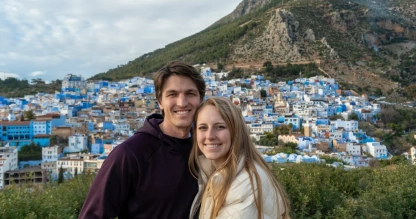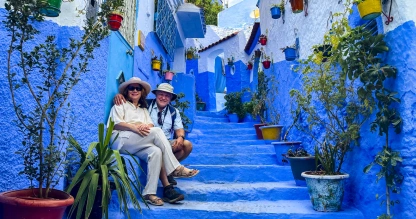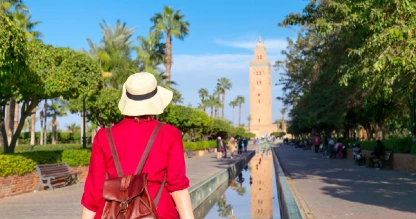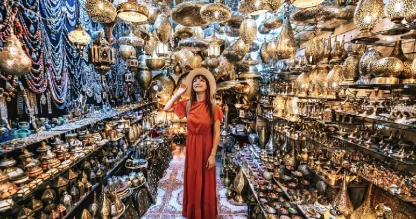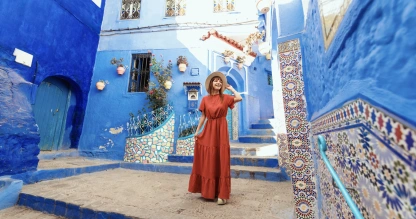
Inside Hassan II Mosque of Casablanca
Standing gracefully on the edge of the Atlantic Ocean, the Hassan II Mosque in Casablanca, Morocco, is one of the most magnificent mosques in the world. Completed in 1993, it’s a masterpiece of modern Islamic architecture, blending traditional Moroccan craftsmanship with contemporary design.
The mosque features the world’s second tallest minaret, rising 210 meters high, and can host over 100,000 worshippers during prayer. With its intricately carved marble, hand-crafted tiles, and breathtaking ocean views, the Hassan II Mosque is not only a place of worship but also a symbol of Moroccan identity and artistry.
First Encounter with the Casablanca Mosque
Visitors often wander for several minutes to find the entrance of Hassan II Mosque. The entrance sits at such a distance that human eyes can barely see it. This brief moment of confusion adds to the excitement of what lies ahead.
Approaching the mosque from the city
The magnificent structure sits on Sidi Mohammed Ben Abdallah Street, about a 20-minute walk from Casablanca-Port train station. A ten-lane boulevard with shopping avenues runs along the southern facade and extends to the Palace Oued el Makhazine in the city center.
The first sight of the towering minaret against the blue Moroccan sky takes your breath away as you walk through this big boulevard. The mosque’s setting carries deep symbolism, standing between land and the Atlantic Ocean, it’s a must-see highlight in Morocco travel packages.
Original impressions of scale and beauty
The sheer size of the complex overwhelms visitors when they arrive. The structure covers 9 hectares (22 acres) and its grandeur hits you right away. The prayer hall measures 200 meters long and 100 meters wide. The surrounding plaza holds up to 80,000 people.
The minaret stands as the crown jewel—reaching 210 meters (689 feet) high. It rules the Casablanca skyline as the world's second tallest minaret. At night, it sends a laser beam toward Mecca that stretches over 30 kilometers. This creates a spectacular guide for the faithful.
The mosque's exterior shows a perfect mix of traditional Islamic elements and modern touches. King Hassan II chose sea green and blue colors to represent "God's blue" and celebrate royal life.
The emotional connection to national pride
The Hassan II Mosque means much more than architectural beauty to Moroccans—it represents their national identity and cultural heritage. King Hassan II commissioned it in 1980 to be "a large, fine building of which Casablanca can be proud until the end of time".
About 12 million Moroccans gave around 3 million euros in just 40 days. Each donor received a special certificate with the mosque's photo. This willing participation shows the deep bond between the monument and its people.
Moroccans take genuine pride in this architectural achievement, despite its cost. The mosque showcases the exceptional work of 6,000 local master craftsmen and artisans. They worked almost exclusively with materials from within Morocco.

Inside the Prayer Hall: A Walk Through Art
The prayer hall of Hassan II Mosque makes you feel like you're stepping into a vast sea of artistic beauty. This rectangular space stretches an amazing 200 meters long and 100 meters wide, leaving visitors in awe.
The grandeur of the main hall
This massive prayer hall welcomes 25,000 worshippers at once. The main floor holds 20,000 men while 5,000 women gather on the raised mezzanine levels along both sides. Tall archways with beautiful designs split this amazing space into three long areas. The central nave reaches up to 40 meters high and towers over the 27-meter side naves. A glass floor section lets worshippers see the Atlantic Ocean's waters below.

Details in zellij, plaster, and woodwork
The mosque's interior reflects the talent of 6,000 master artisans. Small terra cotta tiles called zellij create stunning geometric Islamic patterns across various surfaces. The walls showcase mathematically precise plaster work that artisans shaped while still wet. Cedar wood from the Middle Atlas mountains and beech make up the carved dome and mezzanine. These materials blend perfectly with Agadir marble and Tafraoute granite.
The chandeliers and natural lighting
Fifty-two breathtaking Murano glass chandeliers from Venice light up the space. The prayer hall flows with a series of domes, and these sparkling fixtures hang from each one. Light pours through 28 decorative windows above the north side's large doors, creating a magical dance of light and shadows.
The retractable roof and ocean breeze
The mosque's 1,100-ton retractable roof stands out as an engineering marvel. This amazing feature opens in just five minutes, letting people pray under the open sky. Cast-aluminum tiles cover the roof, which stands 60 meters high and spans 3,400 square meters. These tiles weigh 35 percent less than traditional Fez tiles. The mosque fills with fresh ocean air when the roof opens along with the side doors.

What Makes the Mosque Unique
The Hassan II Mosque of Casablanca stands out from religious buildings worldwide with its stunning architecture and remarkable features.
The minaret and its laser beam
The mosque's minaret reaches an incredible height of 210 meters (689 feet), making it the world's second tallest. This magnificent tower combines spiritual significance with modern technology. The beam creates a stunning path of light that stretches 30 kilometers (19 miles) through the night sky, guiding the faithful toward Islam's holiest city.

Ablution fountains shaped like lotus flowers
The mosque's basement houses some remarkable ablution areas. Worshippers can use 45 beautiful marble fountains crafted like lotus flowers. These artistic fountains serve a practical purpose with their 600 taps. The design lets people move smoothly between washing areas and the prayer hall above.
Underfloor heating and retractable roof
Traditional elements blend perfectly with modern comfort in this mosque. The prayer hall's underfloor heating keeps worshippers warm during cold weather. The massive 1,100-ton roof can open in just five minutes. This engineering marvel stands 60 meters high and covers 3,400 square meters. Sunlight floods the interior when it opens, and evening prayers take place under starlit skies.
Use of local materials and imported touches
Morocco's natural resources shine throughout the mosque's construction. The building showcases cedar wood from the Middle Atlas, marble from Agadir, and Tafraoute's granite. Just two elements came from outside: Murano chandeliers from Italy and specific white granite columns. These imported touches add elegance to this Moroccan architectural gem.

Tips for Visitors and Cultural Etiquette
A visit to the magnificent Hassan II Mosque needs preparation and respect for local customs. These guidelines will give a meaningful experience at this sacred Casablanca landmark.
Dress code and headscarf availability
Every visitor must wear modest attire. Men and women should cover their shoulders, chest, and knees. Women don't need to cover their hair inside the mosque, but many choose to do so as a sign of respect. The mosque staff provides plastic bags for visitors to carry their shoes after removal.
Tour timings and language options
The mosque allows non-Muslim visitors only during guided tours. Tours run from Saturday through Thursday at 9:00, 10:00, 11:00, 12:00, and 15:00. Friday tours happen at 9:00, 10:00, 11:00, and 15:00. Each tour takes about 45 minutes. Visitors can choose from multiple languages including English, Arabic, French, German, and Spanish.
Photography do's and don'ts
The mosque permits photography inside except during prayer times. The mosque rules prohibit flash photography during tours. Video recording remains strictly forbidden.
Respectful behavior inside the mosque
Visitors should stay with their tour groups. The mosque prohibits smoking, eating, and drinking. Visitors must remain quiet and respect the marked boundaries, particularly near the Séguia area.

The Hassan II Mosque is evidence of Morocco's craftsmanship, faith, and national pride. This architectural marvel combines traditional Islamic design naturally with modern engineering achievements.
Ready to discover Morocco's magic? Explore our Morocco Travel Packages and enjoy the best of Middle East trips!
FAQS
1. What is the famous mosque in Casablanca?
The most famous mosque in Casablanca is the Hassan II Mosque. It’s not only the city’s most iconic landmark but also one of the largest mosques in the world, beautifully overlooking the Atlantic Ocean.
2. What is the Hassan II Mosque famous for?
The Hassan II Mosque is renowned for its stunning oceanfront location, 210-meter minaret — the tallest in Africa — and its exquisite Moroccan craftsmanship, including hand-carved marble, zellige tiles, and cedar wood ceilings. It’s a symbol of Moroccan pride and architectural brilliance.
3. Can tourists visit the Hassan II Mosque?
Yes! Unlike many mosques in Morocco, the Hassan II Mosque is open to non-Muslim visitors through guided tours. It’s a wonderful opportunity to admire its detailed interiors and learn about Islamic art and Moroccan culture.
4. What time can you tour the Hassan II Mosque?
Guided tours usually take place several times a day, typically in the morning and early afternoon, except during prayer times and on Fridays. It’s best to check the schedule in advance, as timings can vary seasonally or during religious holidays.
5. How long does a tour of the Hassan II Mosque take?
A guided tour of the Hassan II Mosque usually lasts around 45 minutes to 1 hour. This gives visitors enough time to explore the grand prayer hall, courtyard, ablution room, and admire the ocean views from the mosque’s terrace.

